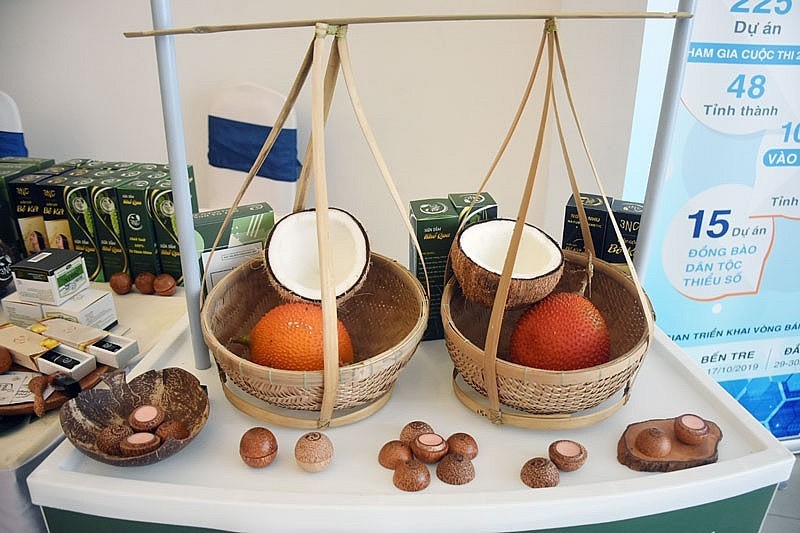In the first five months of this year, Vietnam exported more than 6,400 tons of star anise, equivalent to over 39 million USD, an increase of 129% in volume and 202% in value over the same period last year.
The above information has just been announced by the Vietnam Pepper Association (VPA). Of which, India accounts for 63% of the star anise export market share, the remaining 37% is from China, the US and other markets.
Exporters said that in the first five months of the year, India and China massively bought this spice from Vietnam with triple-digit growth. In addition to the two markets above, the US and the Netherlands are also increasing their purchases of Vietnamese star anise. It is expected that by the end of the year, exports of this spice to these markets could reach over 100 million USD.
According to data from the General Department of Forestry, the total export value of cinnamon and star anise has been increasing continuously, reaching more than 245 million USD in 2020 and about 274 million USD in 2021, accounting for more than 8.3% of the export turnover of vegetables and fruits. This year, the export value of cinnamon and star anise is expected to reach about 276 million USD.
The World Spice Association assesses that Vietnam possesses many valuable spices, one of which is star anise. This type is often used as a spice in dishes such as pho, curry, beef noodle soup, stews, and stews to help create flavor and aroma for the dish.
In Vietnam, the area for growing star anise is about 40,000 hectares, mainly concentrated in Lang Son and Cao Bang with an annual output of more than 16,000 tons. This plant is owned by few countries, mostly in Vietnam and China. The price of dried star anise in Vietnam is fluctuating between 180,000 and 290,000 VND per kg, depending on the quality.
The global spices and flavorings market was valued at 21.3 billion USD in 2021 and will increase to 27.4 billion USD in 2026. Vietnamese star anise is strongly consumed in many regions of South Asia (such as India, Bangladesh), the Middle East (UAE, Pakistan), East Asia (Japan, Taiwan-China, Korea), the US and countries of the European Union - EU.
Vietnamese agricultural products are "in demand" in Southeast Asia
Statistics from the Ministry of Industry and Trade show that in the first 5 months of 2023, Vietnam's agricultural exports to Asia recorded a growth rate of more than 8%, of which the ASEAN market increased by 27% compared to the same period in 2022.
In the first five months of the year, Indonesia imported nearly 400,000 tons of rice, a 15-fold increase over the same period last year. In the ASEAN region as a whole, rice grew by 54% over the same period. Other agricultural products such as coffee and vegetables also had impressive double-digit growth.
"Ministries, sectors, agencies, and the Government all focus on promoting trade and building brands for Vietnamese agricultural products. Enterprises and associated chains are very conscious of building brands. That is one of the fundamental foundations for Vietnamese rice and some agricultural products to have more prestige in the market," said Ms. Nguyen Thi Thanh Thuc, Executive Committee Member, Vietnam Digital Agriculture Association.
"Although climate change has caused many changes, the Mekong Delta still produces two rice crops a year. The world's food supply chain is being broken due to food shortages. This is an opportunity for the Vietnamese rice industry," said Mr. Pham Thai Binh, General Director of Trung An High-Tech Agriculture Joint Stock Company.
Experts say that recently, Southeast Asian countries have increased their imports of Vietnamese agricultural products due to prolonged drought caused by the El Nino weather phenomenon. The Ministry of Industry and Trade, in coordination with the Vietnamese Ministry of Agriculture, is ready to respond to unstable weather conditions.
"From the beginning of the year, the Ministry of Industry and Trade has coordinated with the Ministry of Agriculture and Rural Development, food associations and businesses to predict the impact of adverse weather and its effects on domestic harvest and processing, thereby developing plans to ensure domestic food security, while at the same time most effectively exploiting markets with great demand for Vietnamese rice products," said Mr. Tran Quang Huy, Director of the Asia - Africa Market Department, Ministry of Industry and Trade.
The Ministry of Industry and Trade forecasts that Southeast Asian countries and many countries around the world will continue to increase their imports of Vietnamese agricultural products in the coming time. Enterprises need to meet the quality and packaging requirements of other countries to boost exports and build Vietnamese agricultural product brands, while at the same time calculating the balance to ensure domestic food security.
In recent years, more and more large enterprises have invested in building coconut processing factories. Specifically, at the beginning of this year, in Ben Tre, Ben Tre Coconut Investment Joint Stock Company (BEINCO) inaugurated the BEINCO coconut processing factory with 8 modern production lines producing 8 product lines including: dried coconut meat, coconut milk, concentrated coconut milk, thick coconut creamer, coconut milk with coconut jelly, carbonated coconut water, pure coconut oil, coconut water with coconut meat.
 |
| Coconut products are exported to foreign markets. (Source: Hanoi Moi Newspaper) |
Along with investing in processing plants, BEINCO focuses on developing organic raw material areas to stabilize production and move towards green production, clean food, good for community health. Up to now, BEINCO's raw material areas have reached out of the province and expanded to Tra Vinh, Tien Giang provinces...
Of which, 1,200 hectares of coconut trees have been certified for organic production by Control Union Certification, meeting export standards for the US and European markets. BEINCO's goal is to develop 5,000 hectares of organic coconut trees by 2025. Currently, Beinco's products under the Delta Coco brand have been exported to more than 43 countries around the world and have built a product distribution system covering 63 provinces and cities nationwide.
In addition to BEINCO, the Vietnamese coconut industry also has the participation of many big names such as Luong Quoi Coconut Processing Company Limited with the brand Vietcoco, Ben Tre Import-Export Joint Stock Company (Betrimex) with the brand Cocoxim, GC Food Company, Green Coco Company, Tra Bac Company...
According to businesses, investing in deep processing has contributed to creating a new look for the Vietnamese coconut industry with hundreds of high-value products. Mr. Dang Van Thanh, Chairman of Thanh Thanh Cong Group, shared that in the past, coconut water was mainly produced as colored water for food processing, so the value was low and the output was very unstable. Faced with this situation, Thanh Thanh Cong established a member company, Betrimex, to process and can coconut water.
Accordingly, 90% of the factory's products are exported to many markets and Betrimex is currently the largest canned coconut water factory in Vietnam. Recently, Betrimex has also produced coconut milk products to serve the Muslim market in countries that do not use milk of animal origin.
According to the International Coconut Community (ICC), Vietnamese coconuts have the highest productivity and quality in the world. Domestically, coconut trees are ranked fourth among perennial industrial crops with large planting areas, after rubber, pepper, and cashew. Currently, the coconut area nationwide is about 190,000 hectares, concentrated in the Central Coast provinces and the Mekong Delta. Of which, according to the Vietnam Coconut Association, 7,000 hectares of coconuts have been certified organic according to US and European standards.
In particular, coconut products have great potential for development in the green consumption trend. The Government has issued many policies and directives to implement the reduction and replacement of single-use plastic products, promote green consumption and aim to build a green economy. In particular, the Prime Minister emphasized that by 2025, Vietnam will strive to not use single-use plastic products. This is a great advantage for coconut trees and coconut products such as chopsticks, spoons, household appliances, food processing, cosmetics, etc.
Source





























































































![[Infographic] In 2025, 47 products will achieve national OCOP](https://vphoto.vietnam.vn/thumb/402x226/vietnam/resource/IMAGE/2025/7/16/5d672398b0744db3ab920e05db8e5b7d)





Comment (0)